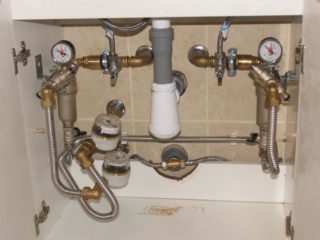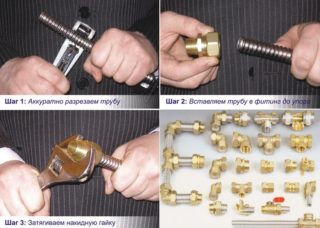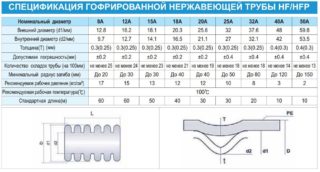In the field of repair and construction work, flexible stainless steel pipes for water began to be used. Thanks to their convenient installation and technical characteristics, the elements have gained popularity. Craftsmen use annealed and unannealed pipes. The former are more expensive and more durable. Although outwardly, both types of tubes do not differ.
Scope of stainless corrugated pipes for water supply

Flexible tubular elements are successfully used in various construction areas:
- installation of heating and water supply systems;
- underfloor heating device;
- laying of air conditioning and ventilation systems;
- installation of electrical wiring in the clamp;
- connection of gas ovens.
In addition, such pipes are used for the construction of fire extinguishing systems.
Specifications
- Internal section - from 15 to 32 mm (upon request, the manufacturer can produce tubes of larger diameter).
- The permissible operating temperature is from -50 to +80 degrees Celsius. At the same time, the flexibility of the element does not suffer even with negative environmental indicators. The highest temperature limit is +110 degrees.
- Bend size - three times the specific diameter of the product.
- The maximum allowable working pressure is 15 bar. However, even at 50 bar, the pipes are tear resistant. A pressure of 210 bar is considered dangerous for flexible steel tubes.
- The roughness coefficient of the inner walls is 0.008.
- The service life is 20 years, provided that the technical recommendations for installation and the scope of application of the tubes are observed.
When buying flexible pipes, it is worth inspecting them for visible defects. If the step of the corrugation is violated, there are distortions of the seam, fittings seem to be faulty or incomplete, it is better to refuse to purchase and turn to another outlet for the goods.
Criterias of choice
Steel flexible water pipes are selected according to the following criteria:
- Internal section. It must completely coincide in diameter with the indicators of the system on which the corrugated element is planned to be installed. There are pipes with a diameter of 1.5 cm, 2 cm, 2.5 and 3.2 cm on the market.
- Type of tube making. Annealed and unannealed. The latter are less strong and when bent while still in the store show some changes in the structure of the material.
- Availability of seals for fittings. They must be mandatory. The quality must meet the established standards: evenness, smoothness, thickness, diameter.
- Length of the product. It is especially important if you are buying a piece of corrugated pipe for connecting a washing machine, toilet, bidet, etc. You can buy material in coils of 50 or more meters.
- The number of turns of the corrugation per 100 mm of the tube. The smaller the cross section of the product, the more there are.
- Manufacturer. The most demanded is KOFULSO products. It is distinguished by a good thickness of O-rings and an impressive weight of the fittings, which is important for a steel element. Another option for reliable products is the Meibes brand. But here the buyer is often frightened off by the price with almost the same technical characteristics as other cheaper products.
Coiled steel tubing is often sold in large coils. Therefore, it is possible to buy the desired cut.
Installation features

Installation of a metal corrugated pipe for water supply is quite simple.The work is carried out in the following sequence:
- Check all union fittings for tight gaskets. They ensure the tightness of the system when connecting the pipe.
- If necessary, they can be additionally treated with a sealant.
- Using a pipe cutter (if necessary), cut out the desired piece of the water pipe.
- At its end, you need to throw a nut and insert a corrugated pipe into it. With the help of a fitting, the element is tightly pulled together with the main line of the water supply.
- A flexible tube is molded and in the same way its second end is joined with plumbing fixtures or another section of the pipe.
It remains to check the system for leaks. If no water leaks anywhere, the flexible element is installed correctly.
Advantages and disadvantages
The main advantages of flexible stainless steel tubes:
- Resistant to corrosion even during long-term operation and constant temperature fluctuations in the system.
- Perfect flexibility, thanks to which you can install plumbing even in the most difficult places and areas of the house.
- Possibility to buy a coil of pipes 50 m long or more, and lay an extended section of the water supply system.
- Ease of installation, which does not require special skills and special tools.
- The minimum number of connections in the pipeline.
- Possibility to install flexible pipe systems with a maximum pressure of 15 bar.
- Heat resistance of stainless steel. The material is suitable for use at temperatures up to +110 degrees.
- Lack of high stress on metal at the junction of corrugated pipes with ordinary ones.
- Low noise level of the transported medium.
- Light weight.
- Service life from 20 to 30 years.
But with all the positive aspects, flexible steel tubes also have a number of disadvantages:
- It is forbidden to use metal corrugation in places with increased mechanical stress. From this, it may become unusable, or you will have to additionally protect the material from the outside.
- Accumulation of dust in the grooves of the corrugation. These pipes are more difficult to maintain. For these purposes, it is advisable to buy a special soft brush.
- Low aesthetics of flexible tubes. You can't leave them open. The situation can be corrected with the help of a plumbing box.
- The need to regularly check the tightness of plastic joints made with polymer union nuts. They can fail. It is often necessary to tighten the nuts all the way, sometimes to change worn out gaskets.
- The high cost of products. Compared to conventional polymer pipes, flexible pipes are much more expensive.
- The need to insure elements against the effects of harmful electrochemical corrosion. Otherwise, they will require replacement.
- Heat loss when using tubes for heating systems when transporting a heat carrier with a high temperature through them.
Flexible steel pipes must never be bricked up in a screed. They should always be accessible. Otherwise, the need for complex labor-intensive repairs in the event of an emergency is not excluded.









